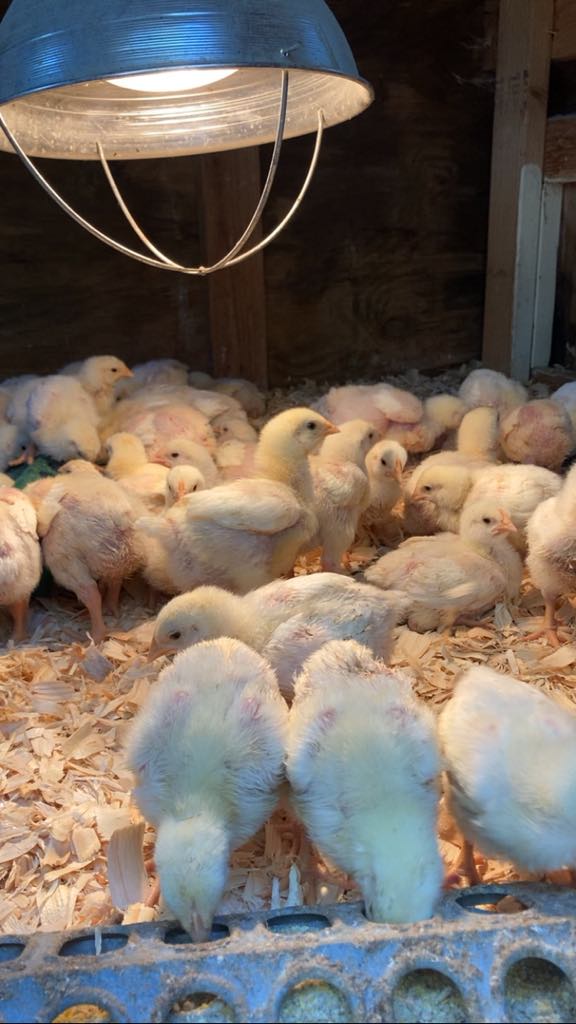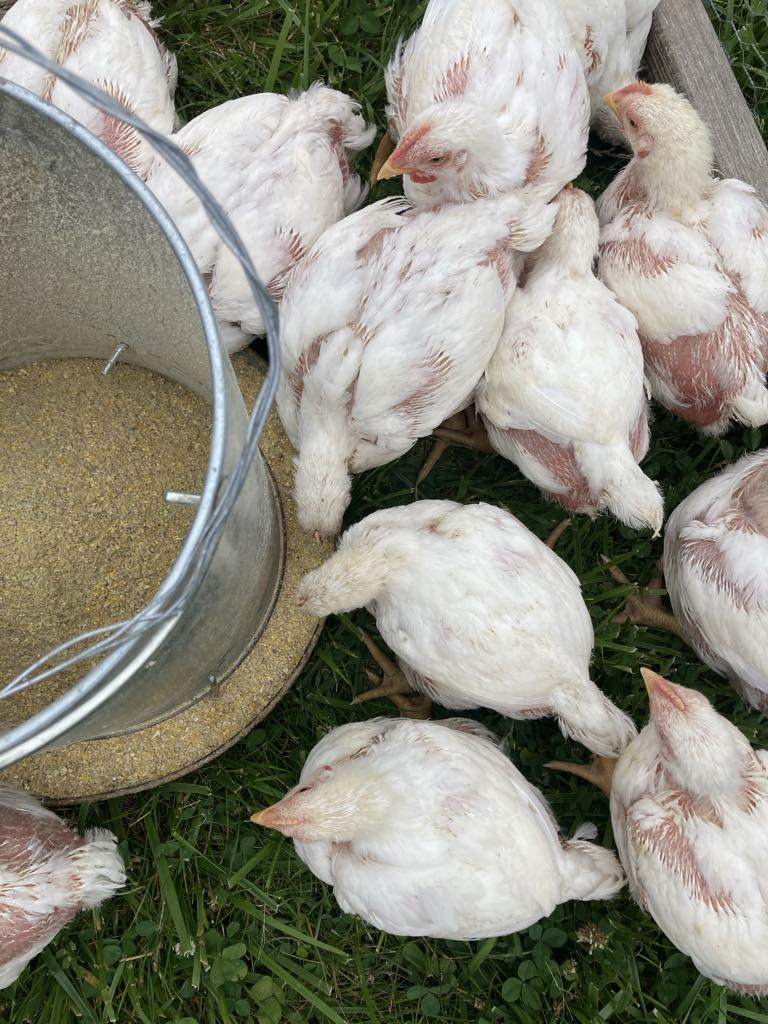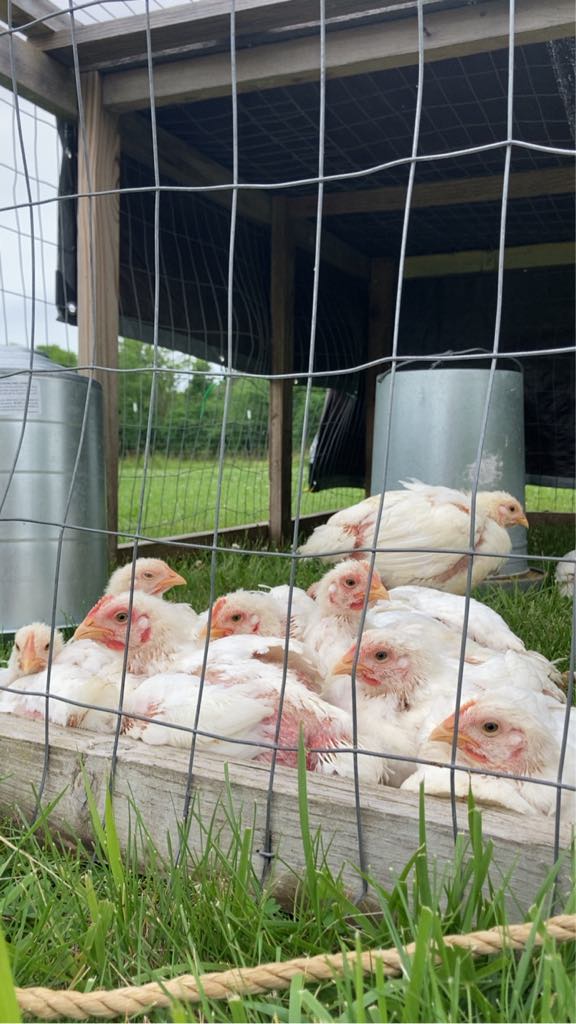For the past 3-4 years, we have raised meat birds to fill our freezer. This has been such a blessing to our family! Not only does it make meal planning easier, but we know exactly what we are feeding our family. We know where the chicks came from, we know how they were cared for and what they were fed. If this is something you are interested in doing for your family, let’s learn how you can get started!

Life tends to be the best teacher of ‘what to do’ and ‘what not to do’ when it comes to raising animals, growing food, or raising kids.
We have learned the hard way how important it is to get your meat chicks off to the right start and I hope you find this simple, straightforward post helpful in equipping you to do just that. If you can raise your own meat, you will make a large dent in your self-sufficiency in the coming years.
Why meat chicks?
Meat chicks are obviously a smaller animal than cows or hogs which makes them easier to handle and more ideal for kids to be involved with. They also have a higher turn over rate and a lower commitment level than larger livestock since hatch to process is only around 8 weeks, depending on what type of meat bird you choose.
What is the first step?
The first step in raising meat chicks is finding a hatchery you can order from, choosing what kind of meat bird you’d like to raise and checking for their availability. Many hatcheries have seasonal availability, but some may ship year-round. Here are a couple Missouri hatcheries to check out:
- Meyer Hatchery: Ships day-old chicks year-round, with minimum order quantities of 3 chicks from April to November and 8 chicks from December to March.
- Cackle Hatchery: Ships baby chicks from February through September, with shipping on Mondays and Wednesdays.
- Other Hatcheries: Many other hatcheries in Missouri or Iowa offer chicks, but their availability and shipping schedules may vary. It’s always best to check with the hatchery directly for the most up-to-date information.
If you want to ensure that you get your chicks at a specific time of the year, you will want to order them in advance, especially if ordering for more popular months like the spring.
Most chicks get shipped by the US postal service the day they hatch to your local post office and you pick them up there. However, some hatcheries may be close enough to where you live that you want to pick them up yourself, which may be an option as well. Picking them up would potentially ensure that your chicks are in better condition and avoid the stress of being sent through the postal service.
What you will need:
Now assuming that you have decided on the type of meat birds you want to raise, as well as, how many you plan to raise, here is what you need to plan to have or get ready before your chicks arrive.
- Brooder – This is a warm, safe place for your chicks to live the first 2-3 weeks you have them. It is a home that is large enough for the chicks to remain un-crowded in, but small enough that you are able to keep it at the appropriate temperature. It needs some ventilation, but to be draft-free! Another thing to be aware of is that it is safe from predators. This can look like a large wooden box with chicken wire over the top, an old water tank, a section of a small building, etc.
- Heat Lamps – Chicks need it to be an environment that is about 90-95 degrees in the beginning. As the chicks feather out and grow over the next 2-3 weeks, the heat can be lowered. Especially as you are working towards transitioning them out to the pasture.
- Bedding – In order to keep the birds warm and clean while in the brooder, you will need to decide on what bedding you plan to use. We have used newspaper in the past because it is free, but this year we used wood chips and were very pleased. It smells nice, it can easily be layered, and then eventually scooped out and placed on a compost pile. Straw is another option, but it makes some people nervous with the heat lamps close by. Compressed wood pellets is another option.
- Waters – There are many different waterer options out there and it will likely be trial and error to find what you like and makes this chore the easiest for your family. Thus far, we have used the 1 gallon waterers.
- Feeders – Feeders can be homemade or bought at the store. We have simply used a couple tray feeders along with the larger gallon feeders.
- Place to source feed – Think through what you plan to feed your birds. We use NEMO Feed here in the Midwest. They provide us with NON-GMO feed from start to finish. Chick starter, Broiler grower, and Broiler finisher feed. Depending on how many birds you plan to raise, this can be purchased in bulk which saves you money. Find out more information about what we feed our birds here.
- Mobile chicken tractor – You don’t need a lot of land, but you will need to have a designated area to move your chickens around on and a pen to be able to move them around in. These pens are called chicken tractors because it is able to be moved around. Be aware of where these will be located, if they will be susceptible to predators, and what you can do to keep your birds safe.
- A plan for processing – If you plan to have someone else process and package your meat, you will need to find a place that will do it and make an appointment for your birds. Slots can fill up fast, so you will want to schedule your processing date once you get your birds.

FAQ
- What breeds are best for meat chickens?
- The most commonly used bird for meat is Cornish Cross. They bulk up nice and produce large breasts which people tend to eat the most of. We tried Red Rangers one year. They were more beautiful and active meat bird, but their growing time was longer and their return was less, in that they did not bulk up as nicely as the Cornish Cross.
- In contrast, we found that the Jumbo Cornish Cross grow TOO fast for our liking.
- How long does it take to raise meat birds?
- Cornish Cross: 6-8 weeks depending on how big you want them (5-7lbs)
- Red Rangers: 9-12 weeks
- What do meat chickens eat?
- Starter feed (0-3 weeks): 22-24% protein
- Grower feed (3-6 weeks): 20% protein
- Finisher feed (last 1-2 weeks): 18% protein
- How much space do they need?
- Brooder/coop: 1-1.5sq ft per bird
- Outdoor tractor: 2-3sq ft per bird
- What are common health issues with meat birds?
- Leg problems: due to fast growth – use slower growing breeds or slightly ration feed toward the end
- Heart attacks: not uncommon in Cornish Cross due to rapid growth
- Coccidiosis: prevent with medicated feed or probiotics. We use unmedicated food and probiotics.
- Should I allow them to free range?
- You can, but Cornish Cross are less active and may not benefit much from free-ranging. By keeping them moved on fresh grass they will benefit from being able to eat the bugs and grass as they are moved.
- What is a chicken tractor?
- It is a moveable pen that allows chickens to graze fresh pasture daily while being protected from predators.
- Can I raise them year-round?
- If you have the right facilities and temperature controlled environments, yes. Typically people raise them from spring to fall and avoid the frigid temps. We have only ever raised them in the spring thus far, but might try doing a fall batch. Our personally preference would be to avoid the middle of summer.
- How do I reduce smell and waste?
- Use deep litter bedding and turn it regularly.
- Keep the coop dry and well-ventilated.
- Move mobile coops at least daily on pasture.
Final tips and thoughts
- Start small – maybe 10-25 birds. This keeps the investment lower and can help prevent overwhelm.
- Start well – Have a thought-out plan of where the birds will be kept warm and well-cared for during those crucial first 2-3 weeks. We have learned this is very important in order to keep the chicks healthy, stress-free and ensure longevity. You want them off to a strong start!
- Start somewhere – if you have a dream of being able to feed your family with the food that you raise, this is totally possible. Just start!
I would love to answer any further questions you have or help you if I can, so always feel free to leave a comment or question and I will get back with you!
Have a wonderful week!





